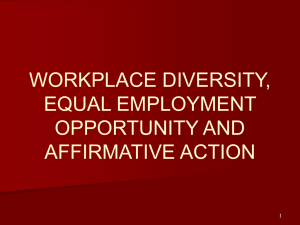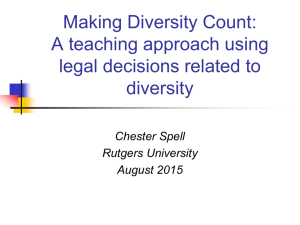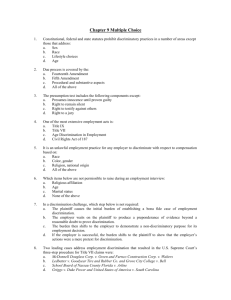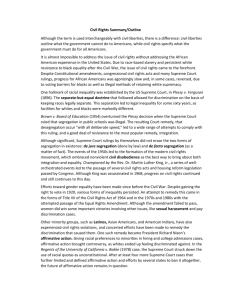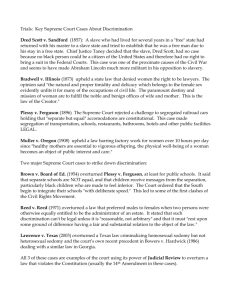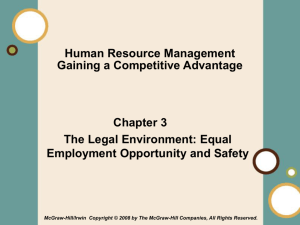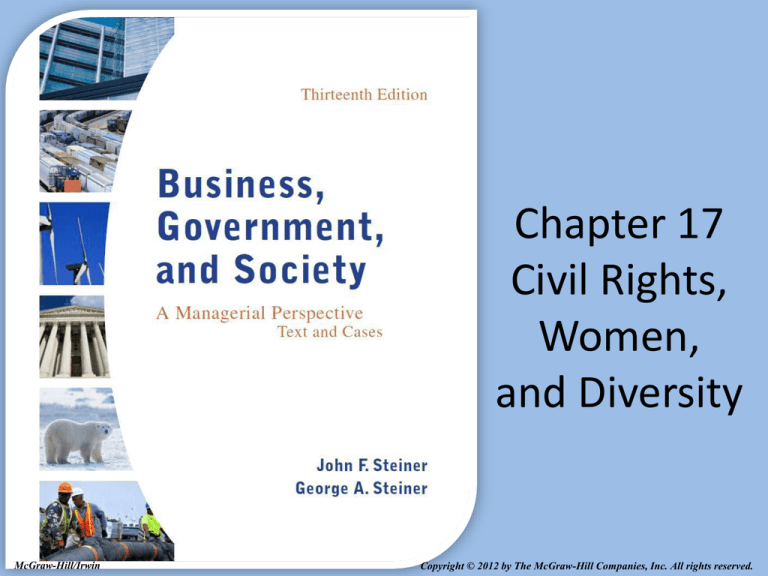
Chapter 17
Civil Rights,
Women,
and Diversity
McGraw-Hill/Irwin
Copyright © 2012 by The McGraw-Hill Companies, Inc. All rights reserved.
The Employment Non-Discrimination Act
o Brooke Waits worked hard and her job was part of
her
o Away from work, Waits was open about being a
lesbian, but at work she sensed that revealing herself
would estrange her from the others
o After being fired, Waits testified before Congress
17-2
The Employment Non-Discrimination Act
o Since the 1970s, supporters in Congress have tried to
pass a law extending workplace protections to victims
of bias such as Waits
o The Employment Non-discrimination Act of 2007
seeks to make it illegal to take any adverse job action
based on sexual orientation
17-3
A Short History of Workplace Civil Rights
The Colonial Era
o Employment discrimination in America can be dated
from 1619
o In the Declaration of Independence, “unalienable”
rights are natural rights
o Natural rights: Rights to which all human beings are
entitled
o The unalienable rights statement in the Declaration
distills a body of doctrine know as the American
Creed
17-4
Civil War and Reconstruction
o In the United States, the issue of slavery rose to a
crisis in the Civil War
o In 1863, President Lincoln issued the Emancipation
Proclamation
o Following the war, Congress passed three
constitutional amendments designed to protect the
rights of former slaves
17-5
Civil War and Reconstruction
o These amendments were supplemented by a series of
civil rights acts passed by Congress
o With little enforcement of these laws, southern states
adopted segregationist statutes called Jim Crow laws
17-6
Other Groups Face Employment
Discrimination
o Native Americans were widely treated as inferior
o When Mexico ceded Texas, 90,000 Hispanics became
U.S. residents, but were victims of a range of
discriminatory actions
o In 1851, Chinese laborers began to enter the country
to be met by economic and racial discrimination
o The earliest Japanese immigrants found similar
inhospitality
17-7
The Civil Rights Cases
o The Civil Rights Act of 1875 was passed to prevent
racial discrimination.
o There was still widespread discrimination against freed
slaves by business and soon a series of cases reached
the Supreme Court
17-8
The Civil Rights Cases
o These cases were consolidated into one opinion by
the Court in 1883 and called the Civil Rights Cases
o The Civil Rights Cases so narrowed the meaning of
the Fourteenth Amendment that it became irrelevant
to a broad range of economic and social bias
17-9
Plessy v. Ferguson
o The Separate Car Act was passed by Louisiana in
1890
o On June 7, 1892, Homer Plessy, who was 7/8
Caucasian and 1/8 African, was asked to move to the
“nonwhite” coach
o Plessy refused and was taken to a New Orleans jail
17-10
Plessy v. Ferguson
o Plessy brought suit, claiming he was entitled to
“equal protection of the laws” as stated in the
Fourteenth Amendment
o The Supreme Court disagreed
o The ruling completed the destruction of the
Fourteenth Amendment as a mechanism to guarantee
civil rights
17-11
Long Years of Discrimination
o Southern legislators were emboldened
by Plessy
o Jim Crow laws spread
o Black workers faced blatant discrimination
o These customs spread to the north
17-12
The Civil Rights Act of 1964
o In the late 1950s and early 1960s, a new civil rights
movement arose
o The pressures of this movement led to many social
reforms, among them passage of the Civil Rights Act
of 1964
o Its Title VII prohibits discrimination in any aspect of
employment
o Title VII created the Equal Employment Opportunity
Commission
17-13
Disparate Treatment and Disparate Impact
o Title VII enforced a legal theory of disparate
treatment
o When Title VII went into effect, employees could no
longer engage in outwardly visible displays of
discrimination
o The flaw in Title VII was that it contained no weapon
to fight disparate impact
17-14
The Griggs Case
o In Griggs v. Duke Power, the Supreme Court held
that diploma requirements and tests that screened out
blacks or other protected classes were illegal unless
employers could show that they were related to job
performance or justified by business necessity
o The Griggs decision, and the legal theory of disparate
impact it created, was necessary for Title VII to work
17-15
The Griggs Case
o In 1978 the EEOC defined illegal disparate impact for
employers with a guideline know as the 80 percent
rule
17-16
Affirmative Action
o Policies that seek out, encourage, and sometimes give
preferential treatment to employees in groups
protected by Title VIII
o The origin of most affirmative action in corporations
is Executive Order 11246
17-17
The Supreme Court Changes Title VII
o The first high-profile challenge came from Allan
Bakke, a white male denied admission to medical
school, claiming reverse discrimination
o The Supreme Court ruled in his favor
17-18
The Supreme Court Changes Title VII
o A white laboratory analyst, Brian Weber, brought suit
against Kaiser Aluminum claiming a promotion
selection procedure violated Title VII
o The Court ruled against him saying Kaiser’s
affirmative action plan embodied “the spirit of the law
17-19
The Supreme Court Changes Title VII
o These rulings established important criteria for
judging the legality of subsequent affirmative action
programs:
o A plan must be designed to break down historic patterns of
race or sex discrimination
o The plan must not create an absolute bar to the advance of
white employees
o The plan must not require the discharge of white workers
o The plan should be flexible and temporary
17-20
The Affirmative Action Debate
o Utilitarian considerations
o Ethical theories of justice raise questions about the
ultimate fairness of affirmative action
o Affirmative action may be debated in light of ethical
theories on rights
17-21
Women at Work
o Around the world more women work than ever before
o In 2009 there were 1.3 billion women in the global
labor force of 3.2 billion, making up 40 percent of the
total
o Participation rates are high in the least-developed
countries, where poverty pushes women into paid
labor
17-22
Women at Work
o Lowest participation is found in Arab nations
o Wherever women work, they are more likely than
men to be in low-productivity jobs in agriculture and
services and to be paid less, even in the same jobs as
men
17-23
Gender Attitudes at Work
o The new feminist perspective asserted that working
women were entitled to the same jobs, rights, and
ambitions as men
o Men who believed in traditional sex-role stereotypes
thought that women were too emotional to manage
well; lacked ambition, logic, and toughness; and
could not sustain career drive because of family
obligations
o In the U.S. belief in the traditional stereotype has
eroded but proves durable
17-24
Subtle Discrimination
o Many workplace cultures are based on masculine
values
o In blue-collar settings, sexism may be blatant; some
men will openly express biases
o In managerial settings, sex discrimination is usually
subtle, even unintentional
17-25
Subtle Discrimination
o Masculine cultures underlie many kinds of
differential treatment
o Men and women learn different ways of speaking in
childhood
o Later in life these conversation styles carry over into
the workplace, where they can place women at a
disadvantage
17-26
Sexual Harassment
o Many women experience sexual harassment at some
time in their careers
o Men use sex-based harassment to define and enforce
gender distinctions
o The EEOC guidelines define two situations where
harassment is illegal:
o Quid pro quo
o Hostile environment
17-27
Figure 17.2 - The EEOC Guidelines on
Sexual Harassment
17-28
Occupational Segregation
o Women are more likely to work in some jobs than
others
o Within corporations and in the economy as a whole,
female jobs are lower in status and pay than typically
male jobs
o Women have less occupational diversity than do men
17-29
Table 17.1 - The Top and Bottom 10
Occupations in Percentages of Women
17-30
Compensation
o Although the gender wage gap is closing, it is
persistent for three reasons:
o Occupational segregation places women in femaledominated occupations that tend to be lower paying
than male-dominated ones
o Women pay a heavy earnings penalty for child bearing
and child rearing, activities that interrupt careers
o The gap reflects elements of sex discrimination
17-31
Compensation
o The pay gap between men and women is worldwide,
although in most other nations it is lower than in the
United States
17-32
Figure 17.3 - The Narrowing Gap in
Weekly Earnings
17-33
Diversity
o Diversity management: Programs to recruit from
diverse groups, promote tolerance, and modify
cultures to include nonmainstream employees
17-34
Key Components of a Diversity
Management Program
o Leadership from the top is critical
o Change in the organization structure creates focal
points for diversity efforts
o Training programs are very popular
o Mentors can be assigned to women and minorities to
overcome isolation in firms where the hierarchy is
predominantly white and male
17-35
Key Components of a Diversity
Management Program
o Data collection is needed to define issues and
measure progress
o Policy changes establish new rules
o Reward systems encourage managers to achieve
diversity goals
17-36
Concluding Observations
o The first national effort to end workplace
discrimination began during the Civil War
o This visionary effort was defeated by social values
contrary to the laws
o In the 1960s, a second effort began with passage of
the Civil Rights Act of 1964
o Today the accumulated corpus of antidiscrimination
law is massive, complex, and controversial but
overall, it works
o Yet, more needs to be done
17-37
Figure 17.4 - Four Civil Rights Eras
17-38

